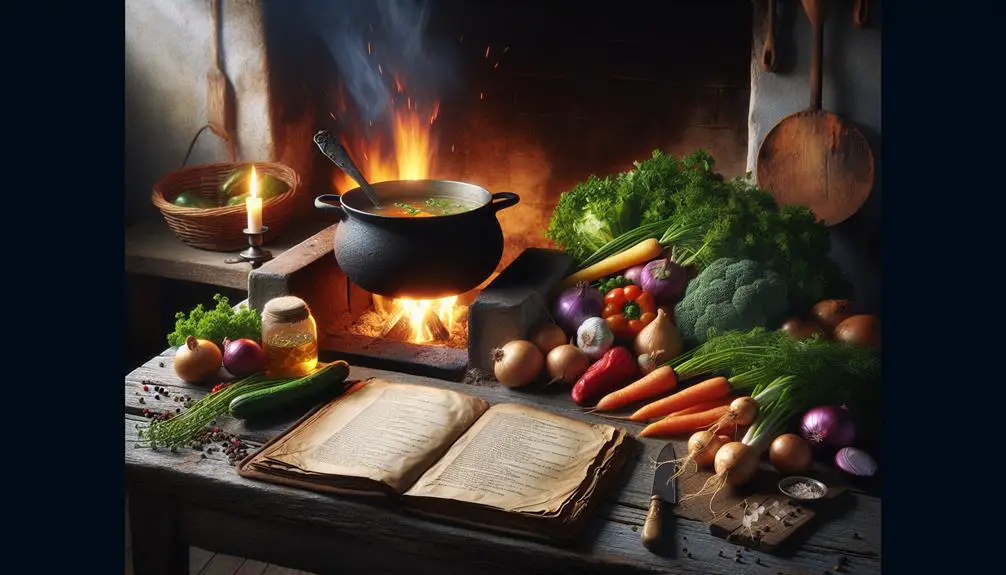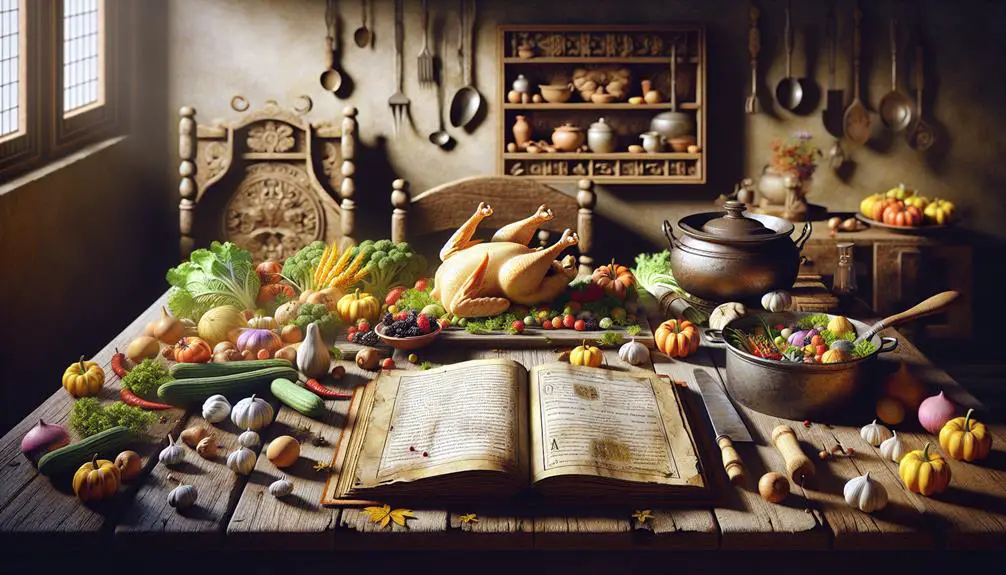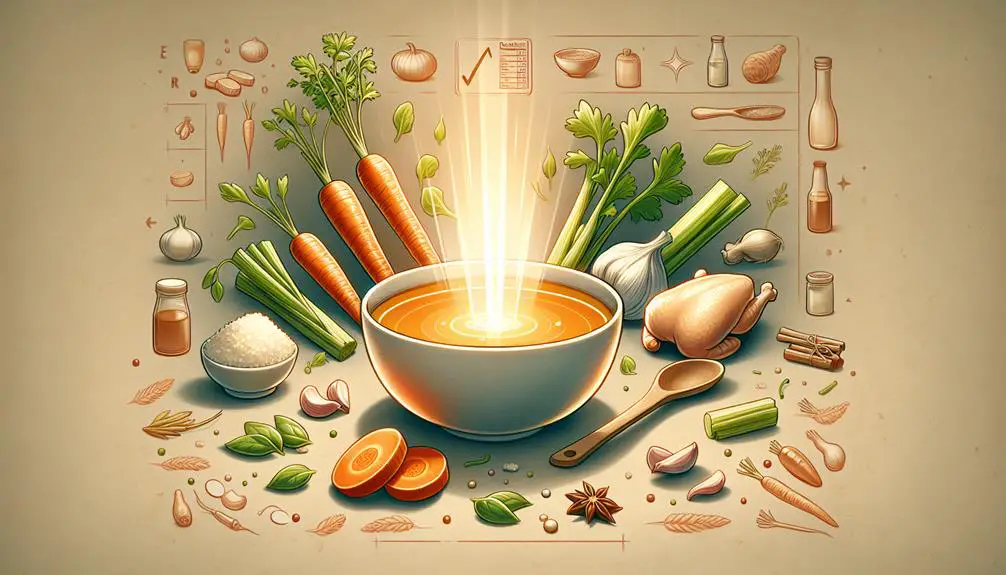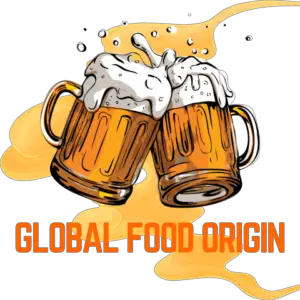Chicken bouillon is a small cube used to add flavor to soups and dishes. It has a long history, originating in 19th century Europe as a convenient way to capture the essence of a home-cooked meal.
Over time, it has become a popular staple in many kitchens due to its convenience and ability to enhance the flavor of dishes.
There are also different variations of recipes that use chicken bouillon to create delicious meals.
The Early Beginnings

You mightn’t realize it, but your pantry’s humble chicken bouillon cube has roots stretching back to ancient civilizations.
These societies laid the groundwork for broth-making, a process that eventually evolved into the bouillon you’re familiar with today.
As you’ll see, key historical events and periods were pivotal in transforming simple broths into the convenient cubes we now use to enhance our cooking.
Ancient Broth-Making Practices
Back in ancient times, people made broths by cooking bones, meats, and veggies in pots over fires. They did this to get flavors and nutrients.
These broths were super important for staying alive because they gave hydration and nourishment.
As time went on, different civilizations like the Egyptians, Greeks, and Romans started making their own special broths.
These broths were the start of the bouillon we have today, which is like a concentrated version of the ancient broths.
Broth was really good at keeping flavors and that’s why it became a big part of cooking and led to the bouillon cubes we use now.
Evolution from Broth to Bouillon
So, like, back in the olden days, people used to make soups and stuff with just basic broths. Then, like, it got fancier and turned into bouillon, which is like a big deal in cooking.
It all started with nomads and their portable soups. Then in the 1700s, this guy Benjamin Thompson made some super solid stock for the Bavarian army, and that’s when modern bouillon started.
Fast forward to the 1900s, companies like Maggi, OXO, and Knorr made bouillon cubes using acid hydrolysis, which made making stock way easier.
During World War I, these cubes got really popular and changed the game for adding flavor to food.
And that’s how we went from homemade broths to those little bouillon cubes that everyone uses now.
Chicken Bouillon’s Emergence

As you explore the journey of chicken bouillon, you’ll find that chicken began to star in broths because of its rich flavor and widespread availability.
This preference led to culinary breakthroughs that enhanced the essence of chicken bouillon.
Innovators in the kitchen, such as renowned chefs and food scientists, played a crucial role in refining the process that today gives you the convenience of savory chicken bouillon cubes.
Introduction of Chicken in Broths
Chicken has been used in broths for a really long time because it tastes so good and it’s everywhere. Back in medieval times, people in Europe started using chicken a lot in broths.
It wasn’t just because it tasted awesome – chickens were easier to get than other meats. Unlike cows, which were used for work and milk, chickens could be raised by regular families, both in the country and the city.
People started liking chicken in broths more and more because it made the food taste really yummy and gave it this special flavor.
It became a super important ingredient, making soups and sauces tasty and healthy. And that’s how we got chicken bouillon today!
Culinary Innovations
Chefs have always wanted to make their broths taste better, and one cool thing they did was invent the dried bouillon cube.
It changed how people could use chicken bouillon and made it super easy to add yummy flavor to dishes without spending a long time cooking.
Famous chefs like Julius Maggi and Justus von Liebig helped make these cubes. They used science and cooking skills to create the modern bouillon cube.
Now, anyone can make tasty food quickly and easily.
Cultural and Regional Influence

As you explore the journey of chicken bouillon, you’ll find it has seasoned the pots of diverse cultures across the globe.
From the robust stews of West Africa to the comforting broths of East Asia, chicken bouillon has become a culinary staple, infusing traditional dishes with its rich flavor.
Pay attention to the unique regional twists and techniques, as they reveal the versatile ways this simple ingredient adapts to local palates.
Global Spread of Chicken Bouillon
Bouillon cubes, like the chicken flavor, have become really popular in many different places. They make traditional foods taste even better and are super easy to use.
In West Africa, they use Maggi cubes to make jollof rice taste really good. In Mexico, they use them to make yummy chicken soup called caldo de pollo.
In the Middle East, they use chicken bouillon to make rice dishes extra tasty, and in the Mediterranean, they use it to make avgolemono soup.
In Asia, they use bouillon cubes to make stir-fries and noodle soups taste amazing.
It’s pretty cool how chicken bouillon is used all around the world and makes food taste so good for everyone cooking at home or in a restaurant!
Regional Variations and Techniques
Chefs and home cooks in different places make chicken bouillon in their own special ways. In West Africa, they use bouillon cubes and spices like grains of paradise for a yummy flavor.
In Mexico, people use Maggi cubes in dishes like pozole and arroz caldo to make them taste even better.
And in Asia, they add star anise and lemongrass to their chicken bouillon for a tasty broth.
Each place has its own way of making bouillon that shows its food history and what people like to eat now.
Industrialization and Commercialization

As you explore the history of chicken bouillon, you’ll find that the commercialization of bouillon cubes was a game-changer in the culinary world.
Pioneers like Maggi, Knorr, and OXO turned a kitchen staple into a global commodity, revolutionizing how we cook and season our food.
This shift not only impacted home cooking by offering convenience but also significantly influenced the food industry, altering the landscape of professional kitchens.
The Advent of Bouillon Cubes
The bouillon cubes changed cooking at home a lot! Big companies like Maggi, Knorr, and OXO made them super popular all over the world.
These little cubes have so much flavor and are super handy for busy cooks.
Julius Maggi started it all in 1908, making soups and stocks much easier to prepare. Then Knorr and OXO joined in with their own versions by 1912.
Now, everyone has bouillon cubes in their kitchen, not just for soups and stews. They make food taste really good and cooking much faster.
But, we also need to think about how much salt and MSG they’ve and how that can affect our health. It’s all about finding a balance between making cooking easy and thinking about what’s good for us.
Impact on Home Cooking and the Food Industry
Bullion cubes have made cooking easier for everyone. They’ve changed how people cook at home and in restaurants.
Now, you can make food taste really good without spending a lot of time. Chefs in restaurants can use these cubes to make sure their food always tastes the same and they don’t waste time.
At home, you can try making different kinds of food and make them taste fancy without a lot of work. Chicken bullion products have made fancy cooking possible for everyone, not just experts.
Modern Uses and Trends

You’ve seen chicken bouillon cubes in pantries around the world, but their role in modern cooking continues to evolve.
Nowadays, chefs and home cooks alike are turning to organic or low-sodium options to create healthier yet flavorful dishes.
These trends reflect a growing awareness of dietary concerns without sacrificing the depth of taste that bouillon brings to the table.
Contemporary Culinary Scene
In today’s kitchens, chicken bouillon is still really popular because it’s easy to use and can be used in lots of different ways. You can use bouillon in cubes, powders, or liquids to make soups, stews, and sauces taste better.
But now, more people want bouillon that’s good for them and the environment. They want to see labels that say the bouillon has natural stuff and not too many extra things added.
Companies are making organic bouillon from chickens that weren’t given antibiotics, and also ones with less salt to help with worries about too much salt.
People are starting to like the organic and low-salt kinds more because they want to be healthy.
When you look at modern cooking, you can see how bouillon has changed. It’s not just about making food taste better, it’s also a good choice for your cooking.
Health and Nutritional Aspects

When you think about chicken bouillon’s health and nutrition, it’s important to know that it has lots of salt and some things like MSG that mightn’t be good for everyone.
These can affect your health, especially if you need to watch how much salt you eat or if MSG bothers you.
Chicken bouillon can make your food taste better quickly, but it’s best to use just a little bit to keep your salt levels in check.
Some bouillon cubes have oils and flavors that aren’t so good for you, but chicken bouillon does have some good things in it too.
It doesn’t have a lot of calories and it can give your food a nice taste. It also has a few nutrients like minerals and B vitamins that you find in chicken.
If you’re choosing chicken bouillon, look for ones with less salt or ones without MSG and fake flavors. Or you can make your own chicken broth at home to have more control over what goes into it.
This way, you can still have the tasty flavor you want without worrying about the not-so-good things in processed bouillon cubes.
Wrapping Up
Chicken bouillon has a cool story because it started in Switzerland and now it’s used all over the world. These little cubes make cooking easier and add lots of flavor to food. But, they can have a lot of salt and extra stuff in them.
Even with that, they show how smart people are in the kitchen and make your food taste great in a hurry. Remember the history when you use them and think about how they fit into cooking today and a long time ago.
